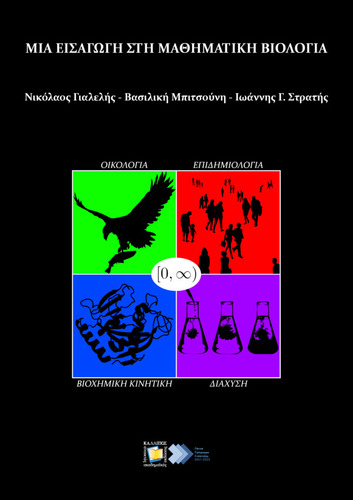| Title Details: | |
|
An Introduction to Mathematical Biology |
|
| Authors: |
Gialelis, Nikolaos Bitsouni, Vasiliki Stratis, Ioannis |
| Reviewer: |
Kavallaris, Nikos |
| Subject: | MATHEMATICS AND COMPUTER SCIENCE > MATHEMATICS MEDICINE AND HEALTH SCIENCES, LIFE SCIENCES, BIOLOGICAL SCIENCES |
| Keywords: |
Mathematical Biology
Mathematical Modelling Applied Mathematics Differential Equations Dynamical Systems Ecology Epidemiology Biochemical Kinetics Diffusion Ordinary Differential Equation ODE Partial Differential Equation PDE |
| Description: | |
| Abstract: |
“Mathematics is Biology’s Next Microscope, Only Better; Biology is Mathematics’ Next Physics, Only Better” is the title of a paper by J. E. Cohen, that gives a particularly successful illustration of the impressive development of Mathematical Biology in the 21st century. Mathematics provides the appropriate means to deal with complex biological systems at various levels of organization and is thus extremely effective (also) in Biology. This book aims to present basic and more advanced methods of Differential Equations (Ordinary (ODE) and Partial (PDE)), Dynamical Systems and Applied Mathematics through applications in Biology. Elements of the following areas of Mathematical Biology are presented: Ecology, Epidemiology, Biochemical Kinetics and Diffusion. In the first part (Ecology), the following models are introduced and studied: exponential (continuous and discrete), logistic (without and with the Allee effect), multi-population (population interaction), Lotka-Volterra (basic, first and second variant of). In the second part (Epidemiology), dynamic epidemiological compartmental models are introduced and studied, and the SIR model (without and with demographic terms) is also studied. In the third part (Biochemical Kinetics), the basic elements of chemical reaction theory, the basic model of enzyme catalysis, the standard and the inverse quasi-steady state hypotheses, and various models of autocatalysis are introduced and studied. In the fourth part (Diffusion) the basic models (exponential and logistic) with a diffusion term and the concept of the pattern index are introduced and studied. The necessary mathematical background is presented and developed at the end of each chapter, after the study of the biological problem and includes: elements of the basic theory of Initial Value Problems (IVPs) for ODEs, discretization of IVPs, stability analysis (linearization, Lyapunov functions, periodic solutions of autonomous IVPs), bifurcation, limit cycles and Hopf bifurcation, basic Poincaré-Bendixson theory, introduction to the concept of non-dimensionalization, locally approximate solutions and their matching, Initial-Boundary Value Problems (IBVPs) for second-order PDEs, degenerate and standard IBVPs, maximum/minimum principle, Fourier series, Sturm-Liouville eigenvalue problems, stationary solutions and their stability, the autonomous standard IBVP for the semilinear diffusion equation and the dependence of stationary solutions on parameters.
|
| Linguistic Editors: |
Gialelis, Nikolaos Bitsouni, Vasiliki Stratis, Ioannis Paxinou, Evgenia |
| Technical Editors: |
Gialelis, Nikolaos Bitsouni, Vasiliki Stratis, Ioannis |
| Graphic Editors: |
Gialelis, Nikolaos Bitsouni, Vasiliki Stratis, Ioannis |
| Type: |
Undergraduate textbook |
| Creation Date: | 10-05-2023 |
| Item Details: | |
| ISBN |
978-618-5726-95-9 |
| License: |
Attribution - NonCommercial - ShareAlike 4.0 International (CC BY-NC-SA 4.0) |
| DOI | http://dx.doi.org/10.57713/kallipos-225 |
| Handle | http://hdl.handle.net/11419/9397 |
| Bibliographic Reference: | Gialelis, N., Bitsouni, V., & Stratis, I. (2023). An Introduction to Mathematical Biology [Undergraduate textbook]. Kallipos, Open Academic Editions. https://dx.doi.org/10.57713/kallipos-225 |
| Language: |
Greek |
| Consists of: |
1. Basic concepts of Ordinary Differential Equations 2. Ecology I 3. Ecology II 4. Ecology III 5. Ecology IV 6. Ecology V 7. Epidemiology I 8. Epidemiology II 9. Biochemical Kinetics I 10. Biochemical Kinetics II 11. Basic concepts of Partial Differential Equations 12. Diffusion I 13. Diffusion II 14. Diffusion III 15. Directions for further study |
| Number of pages |
354 |
| Publication Origin: |
Kallipos, Open Academic Editions |
| You can also view | |
| User comments | |
There are no published comments available! | |

